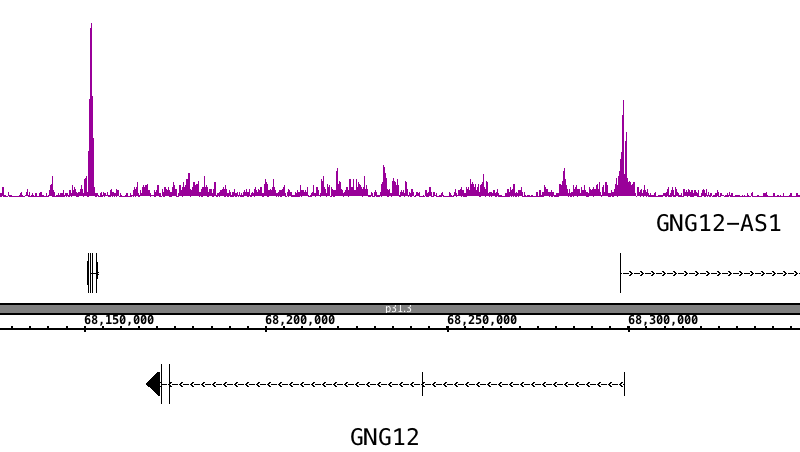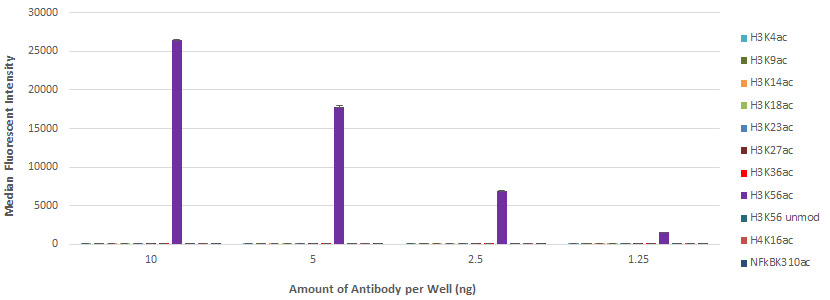AbFlex Histone H3K56ac antibody (rAb)
Host / Isotype
Mouse / IgG2a
Reactivity
Human, Wide Range Predicted
Applications
ChIP-Seq, ELISA
Cat No : 91127,91128 91127
Synonyms
Validation Data Gallery
Product Information
| Tested Applications |
ChIP-Seq, ELISA
Applications Validated by Active Motif: ChIP-Seq: 4 ul each Bead-based ELISA: 25 - 200 ng/ml AbFlex recombinant antibodies are genetically derived from DNA sequences of parental hybridoma clones. For details on the parental clone, see Catalog No. 61061. |
| Tested Reactivity | Human, Wide Range Predicted |
| Host / Isotype | Mouse / IgG2a |
| Class | Recombinant |
| Type | Antibody |
| Modification | Acetylated |
| Immunogen | This Histone H3 acetyl Lys56 antibody was raised against a peptide containing acetyl-Lys56 of human histone H3. |
| Full Name | AbFlex Histone H3K56ac antibody (rAb) |
| Synonyms | histone H3, histone, H3, Histone H3 Acetyl Lys56, Histone H3 Acetyl K56, Histone H3 Ac Lys56, H3 Acetyl Lys56, H3 Acetyl K56, H3 Ac Lys56, Acetylated, Acetyl, Lys 56, Lys56, K56, antibody, antibodies, chip, chromatin immunoprecipitation, H3K56Ac, H3 K56Ac, H3AcK56, H3K56Ac, clone 12.1, sample, recombinant, rAb, rec Ab, AbFlex |
| Molecular weight | 17 kDa |
| GenBank accession number | NP_003522 |
| RRID | AB_2793784 |
| Purification Method | Ni-NTA |
| Buffer | Purified IgG in 140 mM Hepes, pH 7.5, 70 mM NaCl, 32 mM NaOAc, 0.035% sodium azide, 30% glycerol. Sodium azide is highly toxic. |
| Storage | Some products may be shipped at room temperature. This will not affect their stability or performance. Avoid repeated freeze/thaw cycles by aliquoting items into single-use fractions for storage at -20°C for up to 2 years. Keep all reagents on ice when not in storage. |
Background Information
AbFlex antibodies are recombinant antibodies (rAbs) that have been generated using defined DNA sequences to produce highly specific, reproducible antibodies. Each AbFlex antibody contains a 6xHis Tag, a Biotinylation Tag for enzymatic biotin conjugation using the biotin ligase, BirA, and a sortase recognition motif (LPXTG) to attach a variety of labels directly to the antibody including fluorophores, enzymatic substrates (HRP, AP), peptides, drugs as well as solid supports. AbFlex Histone H3K56ac antibody was expressed as full-length IgG with mouse immunoglobulin heavy and light chains (IgG2a isotype) in mammalian 293 cells. Histone H3 is one of the core components of the nucleosome. The nucleosome is the smallest subunit of chromatin and consists of 147 base pairs of DNA wrapped around an octamer of core histone proteins (two each of Histone H2A, Histone H2B, Histone H3 and Histone H4). Histone H1 is a linker histone, present at the interface between the nucleosome core and DNA entry/exit points; it is responsible for establishing higher-order chromatin structure. Chromatin is subject to a variety of chemical modifications, including post-translational modifications of the histone proteins and the methylation of cytosine residues in the DNA. Reported histone modifications include acetylation, methylation, phosphorylation, ubiquitylation, glycosylation, ADP-ribosylation, carbonylation and SUMOylation; they play a major role in regulating gene expression. Lysine N-e-acetylation is a dynamic, reversible and tightly regulated protein and histone modification that plays a major role in chromatin remodeling and in the regulation of gene expression in various cellular functions. Acetylation of histone H3 occurs at several different lysine positions in the histone tail, and is performed by Histone Acetyltransferases (HATs) such as CBP/p300. Acetylation of histones is often associated with transcriptional activation. Histone H3 Lys56 acetylation occurs normally during S phase, but disappears in G2. This modification persists in presence of DNA damage and also plays a role in nucleosome assembly. Rtt109 was shown to be the major histone acetyltransferase (HAT) for Lys56 acetylation.


